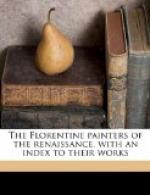XIII.
[Page heading: POPULARISERS OF ART]
Leonardo and Botticelli, like Michelangelo after them, found imitators but not successors. To communicate more material and spiritual significance than Leonardo, would have taken an artist with deeper feeling for significance; to get more music out of design than Botticelli, would have required a painter with even greater passion for the re-embodiment of the pure essences of touch and movement. There were none such in Florence, and the followers of Botticelli—Leonardo’s were all Milanese, and do not here concern us—could but imitate the patterns of their master: the patterns of the face, the patterns of the composition, and the patterns of the line; dragging them down to their own level, sugaring them down to their own palate, slowing them down to their own insensitiveness for what is life-communicating. And although their productions, which were nothing but translations of great man’s art into average man’s art, became popular, as was inevitable, with the average man of their time, (who comprehended them better and felt more comfortable in their presence than in that of the originals which he respectfully admired but did not so thoroughly enjoy), nevertheless we need not dwell on these popularisers nor on their popularisations—not even on Filippino, with his touch of consumptive delicacy, nor Raffaelino del Garbo, with his glints of never-to-be-fulfilled promise.
[Page heading: FRA BARTOLOMMEO]
Before approaching the one man of genius left in Florence after Botticelli and Leonardo, before speaking of Michelangelo, the man in whom all that was most peculiar and much that was greatest in the striving of Florentine art found its fulfilment, let us turn for a moment to a few painters who, just because they were men of manifold talent, might elsewhere almost have become masters. Fra Bartolommeo, Andrea del Sarto, Pontormo, and Bronzino were perhaps no less gifted as artists than Palma, Bonifazio Veronese, Lotto, and Tintoretto; but their talents, instead of being permitted to flower naturally, were scorched by the passion for showing off dexterity, blighted by academic ideals, and uprooted by the whirlwind force of Michelangelo.
Fra Bartolommeo, who in temperament was delicate, refined, graceful, and as a painter had a miniaturist’s feeling for the dainty, was induced to desert his lovely women, his exquisite landscape, and his gentleness of expression for figures constructed mechanically on a colossal scale, or for effects of the round at any cost. And as evil is more obvious than good, Bartolommeo, the painter of that masterpiece of colour and light and shade, of graceful movement and charming feeling, the “Madonna with the Baptist and St. Stephen” in the Cathedral at Lucca, Bartolommeo, the dainty deviser of Mr. Mond’s tiny “Nativity,” Bartolommeo, the artificer of a hundred masterpieces of pen drawing, is almost unknown; and to most people Fra Bartolommeo is a sort of synonym for pomposity. He is known only as the author of physically colossal, spiritually insignificant prophets and apostles, or, perchance, as the painter of pitch-dark altar-pieces: this being the reward of devices to obtain mere relief.




